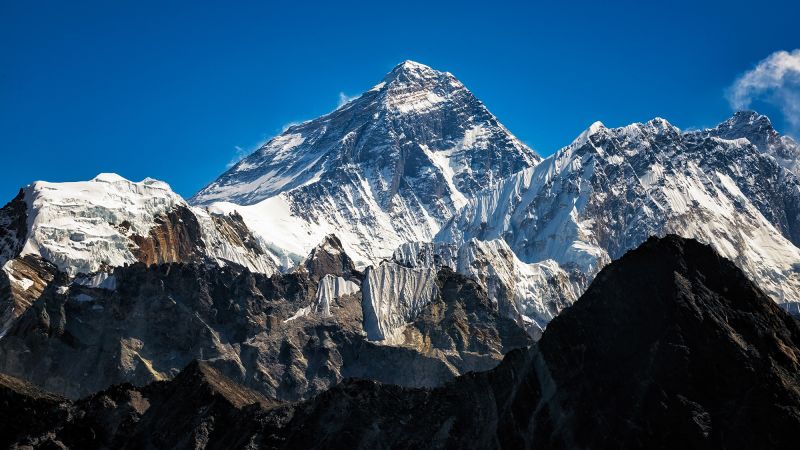It started in the pub, over a couple of beers. Four ex-military friends had been speaking about taking on an adventurous trip to raise money for a veterans’ charity, when one brought up the prospect of summiting Everest.
“We’re all busy people. My response was, ‘No way I can spend four to six, maybe even eight weeks out climbing Everest — it’s just almost impossible,” Al Carns, a British lawmaker told CNN.
But one of his friends had a counter challenge: he had heard about a novel way of altering the acclimatization process that could allow them to summit the 8,849-meter (29,032 feet) peak in under a week — by inhaling a noble gas called xenon ahead of the expedition.
This month, the men — a pilot, a politician, a businessman and an entrepreneur — will attempt to summit Everest in seven days: they will fly from the UK to Kathmandu, where they will take a helicopter to base camp, and attempt to summit the mountain in a few days, before returning home in what would be a historic first.
This, they hope, will be made possible by inhaling the noble gas xenon 10 days prior, as part of a tour with Furtenbach Adventures.
“Before you can go to climb Mount Everest, you need to adapt your body to the low levels of oxygen,” Lukas Furtenbach, CEO of Furtenbach Adventures, told CNN Travel.
“You can do this in a traditional way — trekking to base camp and then several rotations on the mountain, and then, after weeks of acclimatizing, your body is ready to build enough red blood cells, and then you can start your summit attempt,” he added.
Furtenbach said that he had spoken at length with a doctor who was an expert in noble gasses, including xenon, which is sometimes used as an anesthetic.
Furtenbach was convinced of its ability to increase the body’s production of erythropoietin, also known as EPO, a hormone naturally produced by human kidneys to stimulate red blood cell production.
“One side effect of using Xenon is that it triggers the body’s EPO production, and that results in an increase of red blood cells in the blood — and that’s the same effect that you have when you are acclimatizing at real altitude,” he added.
Furtenbach told CNN he first tested the effects of gas on himself while summiting Argentina’s 6,961-meter Aconcagua, and one year later took it to Everest to trial with a larger team. At the time of speaking with CNN, he had used xenon five times.
Medical concern
Deaths on Everest can be caused by several factors. Mountaineers venturing above 8,000 meters, or 26,000 feet, in what is known as Everest’s “death zone” are faced with low levels of oxygen.
“You become oxygen depleted, and this affects all of the body, particularly the brain and the lungs,” Andrew Peacock, emeritus professor in medicine at the University of Glasgow’s School of Cardiovascular & Metabolic Health, told CNN.
This, he explained, can lead to cerebral edema (swelling of the brain) pulmonary edema (fluid accumulation in the lungs), as well as affecting the kidneys, the liver, and the muscles.
In addition to exhaustion and dehydration, mountaineers can also find themselves at risk of avalanches, hypothermia and falling.
Furtenbach’s plan to use xenon for high-altitude expeditions has rattled some cages, including at the International Climbing and Mountaineering Federation (The UIAA), which released a statement saying: There is no evidence that breathing in xenon improves performance in the mountains, and inappropriate use can be dangerous.
“Although a single inhalation of xenon can measurably increase the release of erythropoietin, this increase is not sustained over four weeks’ use, nor is it associated with any changes in red blood cells. According to the literature, the effects on performance are unclear and probably non-existent.”
The UIAA warned that as an anesthetic, xenon should be considered a medicine, and could result in “impaired brain function, respiratory compromise, and even death” if used in an unmonitored setting.
“One study showed significant sedation in people using it at doses recommended for mountaineering. Even slight sedation is detrimental in the potentially dangerous setting of high-altitude mountaineering,” it added.
The federation also noted that the substance has been banned by the World Anti-Doping Agency (WADA) since 2014.
Peacock told CNN that he was skeptical of xenon’s effect on stimulating erythropoietin in such a short timeframe, warning that “the effect on the red blood cells takes weeks.”
“Xenon is an anesthetic gas, and it stimulates erythropoietin. That level of hormone then stimulates the bone marrow, which boosts red blood cells, which increases your oxygen-carrying capacity. And that probably does happen, but I really don’t think it happens in the timeframe that these people are talking about,” he explained.
Peacock also cautioned that as xenon is an anesthetic gas, “that means it puts people to sleep. So what we’re worrying about slightly, is the side effects, or the residual effects of inhaling an anesthetic gas when you’re going to extreme altitude.”
Carns told CNN: “When oxygen first came on the scene in alpine mountaineering, it was seen as a taboo, and that it shouldn’t be done. Now, it’s used by everybody. Helicopters to base camp were seen as a taboo, but now quite a lot of people do that as well.”
‘Like a speed tour of the Sistine Chapel’
Climbing Everest has changed dramatically since Edmund Hillary and Tenzing Norgay first successfully summited the mountain in 1953. Now, with access to Sherpa guides, porters, supplemental oxygen and top-of-the-range equipment, the mountain is far more accessible to hobbyists and tourists.
“Everest stopped being mountaineering in the pure climbing, mountaineering sense, back when it began to be guided in the 90s,” Will Cockrell, author of “Everest, Inc.” told CNN, adding that guiding outfits have long been dreaming up innovative ways of cutting expedition times.
A classic expedition on Everest can take between six to 10 weeks and involves multiple rotations to camps on the mountain or its neighboring peaks so that the body acclimatizes to high altitude, before a final summit push.
“It varies person to person, but let’s say it takes about four weeks to gradually acclimatize to an altitude of 6,000 meters, which is Everest Base Camp,” Peacock explained.
Cockrell noted that for many years, guiding providers have been providing “flash” expeditions where clients sleep in a hypoxic chamber before they reach Nepal to speed up the acclimatization process to reduce the trip to between three and four weeks.
“The knee-jerk reaction from climbers who still want to argue that about this as if it’s a climbing pursuit, which is a really antiquated way of even looking at Everest anymore, is to say these people aren’t climbers and be grumpy about it,” Cockrell said.
But, he added, “no one’s really there claiming to be a climber or a mountaineer — they’re all claiming to be at Everest for these very personal reasons, right? They’re seeking out the same sort of transformation that climbers do when they climb mountains, but you also get it when you run a marathon.”
Mountaineering purists, Cockrell noted, might take issue with the speed at which people summit. “When we humans go do these things, whether it’s traveling, climbing a mountain — isn’t part of the point to enjoy the process, and as they say, smell the roses?
“It’s a little bit like signing up for the speed tour of the Sistine Chapel,” he says, adding that it is perhaps more useful to think of a regular Everest expedition and speed ascents of the mountain as completely separate entities, each with their own objectives.
Furtenbach, whose outfit is so far the only one to offer this xenon-reliant tour, argued that his new style of expedition could actually be considered less dangerous than other types.
“The less time you spend on the mountain, the less time you spend doing rotations on the mountain, the less exposure time you have to risks on the mountain, like avalanches, rock fall,” he told CNN.
Cockrell warned that this style of expedition is still likely to come with a great deal of risk.
“You’re reducing your self-sufficiency. You’re making yourself even more reliant on external factors, such as the xenon gas working and perhaps needing more support from guides and Sherpa guides, because in case something goes wrong, because you’re less prepared, you’re less acclimatized,” he explained.
“If you have a problem with it high up, then you’re so not acclimatized your body has a much higher chance of literally just going into full-blown altitude sickness, like rapidly to where you could just die or pass out,” he added.
Carns told CNN he’s comfortable with the risks, as are the other members of the team — Garth Miller, Kevin Godlington and Anthony Stazicker — who have also had careers in the armed services.
“We’re all from a military background, very specialist elements in the military. Our whole careers have been built around the ability to balance risk, to take risk and mitigate it in the most effective ways.
“Xenon is only one small section of it that probably enhances our ability by five or 10% and particularly reduces the chances of high altitude sickness or edema, which are the big things that will catch us out,” he explained.
The team has been using hypoxic chambers as part of pre-altitude training, as well as following a diet and exercise plan.
“There’s no shortcuts in this space, we spent easy, over 500 hours sleeping in a hypoxic tent, (and there’s) a lot of exercise involved to make sure you’re ready and fit and capable,” Carns added.
Still, there are no guarantees the team will be successful, and Carns admitted that they can’t be sure that their training will reduce the impacts of altitude.
“I always say there’s a 30% chance of us doing this in seven days, and about 70% chance of us doing it under 21 days,” he explained.
Furtenbach is careful to note that this type of expedition — costing around 150,000 euros (around $170,147), is unlikely to become the main type that customers choose.
“We want to show what is possible in a week… It will always be very niche,” he said.
“Of course, the experience is different if you spend 10 weeks on an expedition, or seven weeks or seven days — but in the end, that’s a personal decision. We offer a long traditional expedition. We offer a medium-length expedition, and now a very short one.
“It’s not that I’m saying this is the only way to climb Mount Everest, and this is the future way. It’s one way to climb Mount Everest, and I think there should be a coexistence of different styles of climbing.”
The post They want to climb Everest in a week using an anesthetic gas. Critics warn it’s dangerous appeared first on CNN.




